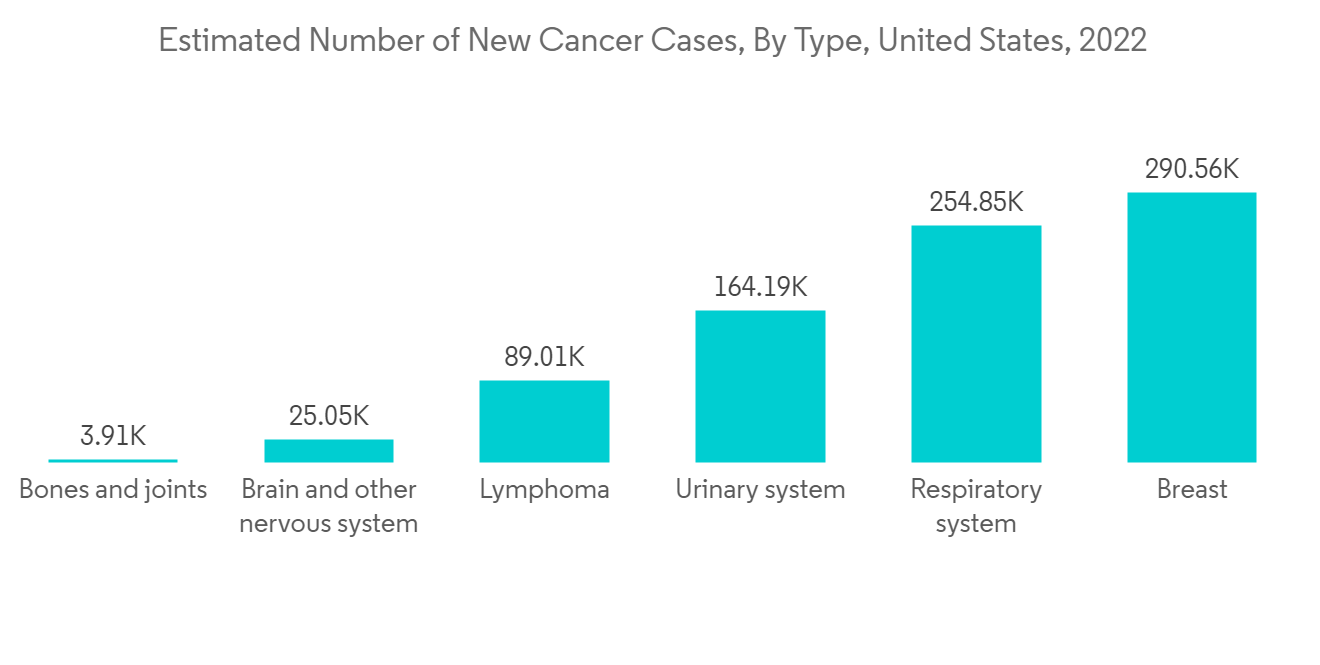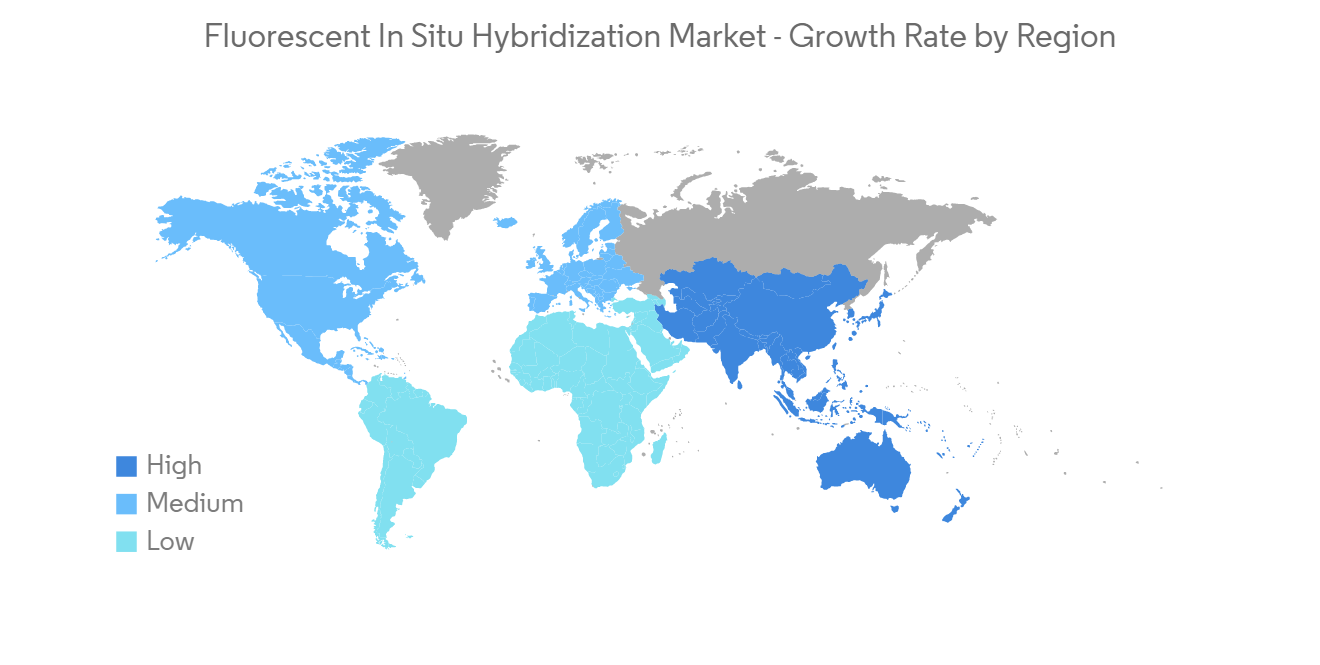 |
市場調査レポート
商品コード
1273332
FISH(蛍光 in situ ハイブリダイゼーション)市場- 成長、動向、予測(2023年-2028年)Fluorescent In Situ Hybridization Market - Growth, Trends, and Forecasts (2023 - 2028) |
||||||
● お客様のご希望に応じて、既存データの加工や未掲載情報(例:国別セグメント)の追加などの対応が可能です。 詳細はお問い合わせください。
| FISH(蛍光 in situ ハイブリダイゼーション)市場- 成長、動向、予測(2023年-2028年) |
|
出版日: 2023年04月14日
発行: Mordor Intelligence
ページ情報: 英文 117 Pages
納期: 2~3営業日
|
- 全表示
- 概要
- 目次
FISH(蛍光 in situ ハイブリダイゼーション)市場は予測期間中にCAGR 6.8%で成長すると予測されます。
COVID-19は、FISH(蛍光 in situ ハイブリダイゼーション)を展開する調査研究の高まりにより、調査市場に多大な影響を与えました。例えば、2022年11月にPLOS One Journalに掲載された論文では、唾液中のSARS-CoV-2の検出にFISH(蛍光 in situ ハイブリダイゼーション)の評価法が使用されました。すべての唾液サンプルをCy3標識したSARS-CoV-2特異的DNAプローブでFISHし、蛍光顕微鏡で手動解析しました(概念実証済み)。しかし、世界的にがんや遺伝性疾患の有病率が上昇していることから、予測期間中は安定した成長率を示すと予想されます。
また、がんや遺伝性疾患の負担の増加やFISH製品の技術革新は、調査対象市場の成長に積極的に影響を与えています。
カナダがん協会2022年5月更新版によると、2022年に3万人のカナダ人が肺がんおよび気管支がんと診断され、すべての新規がん患者の13%を占めると推定されています。FISH(蛍光 in situ ハイブリダイゼーション)は、染色体異常を見つけるために様々な種類のがんの診断に使用されているため、FISHの需要が増加し、市場を牽引しています。
さらに、FISH(蛍光 in situ ハイブリダイゼーション)は、染色体上の特定のDNA配列を検出して位置を特定するために使用されます。また、遺伝性疾患を診断するための分子細胞遺伝学的手法としても使用されています。例えば、2021年9月に発表された「World Alzheimer Report」によると、世界で5,500万人以上の人が認知症を抱えて暮らしています。これは2030年には7,800万人に達すると予測されています。また、アルツハイマー病協会の2021年報告書によると、米国では2021年に65歳以上の米国人が620万人のアルツハイマー型認知症を抱えていると推定されています。2050年には、65歳以上のアルツハイマー型認知症患者は1,270万人に増加すると予測されています。アルツハイマー病の世界の負担増は、この病態の遺伝子検査に使用されるFISHの需要を急増させ、研究セグメント市場の成長につながっています。
FISHは主に、特定のDNA配列の特定、遺伝性疾患の診断、遺伝子マッピングに使用され、ゲノミクスにおけるその使用は極めて重要です。バイオテクノロジーや製薬会社、政府機関などが、ゲノミクス分野の研究や技術革新のために資金や投資を増やしていることが、市場の成長を促進すると推定されます。例えば、NIH国立ヒトゲノム研究所(NHGRI)2022年報告書によると、ヒトゲノム研究のための2022年度米国大統領予算要求は6億3,300万米ドルで、前年度と比較して1,700万米ドル増加しています。人類の健康を改善するために、NHGRIは様々なグループと交流し、ゲノミクス研究の実施と資金提供を行い、次世代のゲノミクス専門家を教育しています。NHGRIによるゲノム研究への巨額の投資は、研究中に大量のFISHを利用することが予想され、予測期間中の市場成長を促進することが期待されます。
したがって、がんや遺伝性疾患の高い有病率、FISHの高い有用性につながる資金調達の増加などの前述の要因のおかげで、調査市場は分析期間中に成長を示すと予測されます。しかし、細胞遺伝学における新たな診断技術に関する認識不足が、市場の成長を阻害する可能性があります。
FISH(蛍光 in situ ハイブリダイゼーション)市場の動向
FISH(蛍光 in situ ハイブリダイゼーション)市場は、がん分野が大きく成長すると予想される
体外診断の普及、世界のがん罹患率の高さ、がん診断に用いられるFISH(蛍光 in situ ハイブリダイゼーション)の技術的進歩などの要因により、がん分野は予測期間中に大きな市場シェアを占めると予測されています。
細胞遺伝学的手法は、がんの染色体異常の検出において重要な役割を果たします。米国がん協会「Cancer Statistics 2023」によると、2023年に米国で新たに診断されるがん患者は190万人と予測されています。また、オーストラリア保健福祉研究所(AIHW)の2021年報告書によると、オーストラリアでは2021年に合計150,782人の新規がん患者が発生すると予測されています。さらに、ICMR 2021年報告書によると、インドにおけるがん患者数は2021年の2,670万人から2025年には2,980万人に増加する見込みであることが確認されました。世界的にがんの負担が大きいため、病気の診断や治療計画に役立つFISHの有用性が高まり、セグメントの成長を促進することが期待されます。
米国FDAが推奨するHer2遺伝子検出のための調査におけるFISHの利用が増加していることも、セグメントの成長に寄与しています。例えば、2022年8月にContrast Media Molecular Imaging Journalに掲載された研究論文によると、乳がん患者のHer2遺伝子の検出においてFISHが使用されました。研究論文によると、高い検出特異性、高感度、強い実験時間という利点から、蛍光顕微鏡を伴うFISH(蛍光 in situ ハイブリダイゼーション)技術は、関連分野でますます支持されています。FISHは、非小細胞肺がんのMET(肝細胞増殖受容体)遺伝子の異常検出や乳がんの遺伝子検出などに非常に有効です。したがって、これらの要因は、fluorescent in situ hybridization市場のがん分野にプラスの影響を与えると予想されます。

予測期間中、北米が重要な市場シェアを占めると予想される
北米は、慢性疾患の負担が大きく、FISH関連の製品承認が進んでいることから、FISH(蛍光 in situ ハイブリダイゼーション)市場において支配的な地域となると予想されます。
カナダがん協会の乳がん統計2022年版レポートによると、2022年に乳がんと診断されるカナダ人女性は2万8,600人と推定され、女性の新規がん患者全体の25%に相当します。平均して、毎日78人のカナダ人女性が乳がんと診断されることになります。同地域では乳がんや遺伝性疾患の負担が大きいため、同地域の市場成長を促進することが期待されています。
FISH法は、特定のDNA配列の特定、遺伝性疾患の診断、遺伝子マッピング、さまざまな種類のがんに寄与する新規がん遺伝子の同定に使用されます。この地域では、がんゲノミクスへの支出が多いため、FISH(蛍光 in situ ハイブリダイゼーション)の有用性が促進されると推定されます。例えば、NIH Research Portfolio Online Reporting Tool(RePORT), May 2022 の報告によると、米国におけるがんゲノミクスへの支出は、2021年に11億6,000万米ドル、2022年に12億2,000万米ドルです。同地域における遺伝子工学プロジェクトへの支出の増加は、予測期間中に同地域の市場成長を促進すると予想されます。
さらに、前述のNIHの報告書によると、遺伝学の研究に対する資金は、2021年に110億1,000万米ドル、2022年に114億8,000万米ドルであると報告されています。米国では遺伝学への支出負担が大きいため、調査中のFISHの有用性が推進され、予測期間中に同地域の市場成長が増強されると予想されます。

FISH(蛍光 in situ ハイブリダイゼーション)産業の概要
FISH(蛍光 in situ ハイブリダイゼーション)市場は、世界的および地域的に事業を展開する複数の企業の存在により、その競争は緩やかなものとなっています。競合情勢には、重要なまたは主要な市場シェアを保有する国際企業および地域企業の分析が含まれています。市場を独占している企業には、Abnova Corporation、Genemed Technologies, Inc.、Biocare Medical, LLC、Qiagen(Exiqon A/S)、Agilent Technologies、Merck KGaA、Biodot Inc、PERKINELMER Inc、ThermoFisher Scientific Inc、およびF. HOFFMANN-LA ROCHE LTD.
その他の特典:
- エクセル形式の市場予測(ME)シート
- 3ヶ月間のアナリストサポート
目次
第1章 イントロダクション
- 調査の前提条件
- 本調査の対象範囲
第2章 調査手法
第3章 エグゼクティブサマリー
第4章 市場力学
- 市場概要
- 市場促進要因
- がんや遺伝性疾患の負担増
- 製品の進歩
- 市場抑制要因
- 細胞遺伝学の新たな診断技術に関する認識不足
- ポーターファイブフォース
- 新規参入業者の脅威
- 買い手/消費者の交渉力
- 供給企業の交渉力
- 代替品の脅威
- 競争企業間の敵対関係
第5章 市場セグメンテーション
- 製品タイプ別
- 分析機器
- キット・試薬
- ソフトウェア&サービス
- アプリケーション別
- がん
- 遺伝性疾患
- その他
- 地域別
- 北米
- 米国
- カナダ
- メキシコ
- 欧州
- ドイツ
- 英国
- フランス
- イタリア
- スペイン
- その他欧州
- アジア太平洋地域
- 中国
- 日本
- インド
- オーストラリア
- 韓国
- その他アジア太平洋地域
- 中東・アフリカ地域
- GCC
- 南アフリカ
- その他中東とアフリカ
- 南米
- ブラジル
- アルゼンチン
- その他南米
- 北米
第6章 競合情勢
- 企業プロファイル
- Abnova Corporation
- Agilent Technologies
- Biocare Medical, LLC
- Biodot Inc.
- F. HOFFMANN-LA ROCHE LTD.
- Genemed Technologies, Inc.
- Merck KGaA
- PERKINELMER INC
- Qiagen(Exiqon A/S)
- ThermoFisher Scientific Inc.
第7章 市場機会および将来動向
The Fluorescent In Situ Hybridization Market is poised to grow at a CAGR of 6.8% over the forecast period.
COVID-19 profoundly impacted the studied market owing to the rising research studies deploying fluorescence in situ hybridization. For instance, in an article published in the PLOS One Journal in November 2022, fluorescence in situ hybridization (FISH)-based evaluation method was used for the detection of SARS-CoV-2 in saliva. All saliva samples were FISHed with a Cy3-labeled SARS-CoV-2-specific DNA probe and were analyzed manually by fluorescence microscopy (proof-of-concept). However, the market is expected to show a stable growth rate during the forecast period owing to the rising prevalence of cancer and genetic diseases globally.
In addition, the growing burden of cancer and genetic diseases and innovation in FISH products are actively affecting the growth of the studied market.
According to the Canadian Cancer Society May 2022 update, it was estimated that 30 thousand Canadians would be diagnosed with lung and bronchus cancer, representing 13% of all new cancer cases in 2022. As fluorescent in situ hybridization is used to diagnose various types of cancer to find chromosomal abnormalities, there is an increasing demand for FISH, thereby driving the market.
Furthermore, fluorescence in situ hybridization (FISH) is used to detect and locate a specific DNA sequence on a chromosome. It is also used as a molecular cytogenetic technique to diagnose genetic diseases. For instance, according to the World Alzheimer Report published in September 2021, over 55 million people live with dementia worldwide. This is forecasted to reach 78 million by 2030. Also, as per the Alzheimer's Association 2021 report, an estimated 6.2 million Americans aged 65 and older were living with Alzheimer's dementia in 2021 in the United States. By 2050, the number of people aged 65 and older with Alzheimer's dementia is projected to increase to 12.7 million. The increasing burden of Alzheimer's disease globally surges the demand for FISH used in the genetic testing of the disease condition, thereby leading to the growth of the studied segment market.
FISH is mainly used for locating specific DNA sequences, diagnosis of genetic diseases, and gene mapping; its use in genomics is vital. The increasing funding and investment by biotechnology and pharmaceutical companies and government organizations for research and innovation in the field of genomics is estimated to propel market growth. For instance, according to the NIH National Human Genome Research Institute (NHGRI) 2022 report, the FY 2022 United States President's Budget request for human genomics research is USD 633.0 million, an increase of USD 17.0 million compared with the previous year. In order to improve human health, NHGRI interacts with a variety of groups, performs and funds genomics research, and educates the next generation of genomics specialists. The huge investment by the NHGRI in the genomics study is expected to utilize a large amount of FISH during the research, which is expected to propel the market growth during the forecast period.
Therefore, owing to the aforementioned factors, such as the high prevalence of cancer and genetic diseases and rising funding leading to the high utility of FISH, the studied market is anticipated to witness growth over the analysis period. However, a lack of awareness about emerging diagnostic technologies in cytogenetics is likely to impede market growth.
Fluorescent In Situ Hybridization Market Trends
Cancer Segment is Expected to Show a Significant Growth in the Fluorescent In Situ Hybridization Market
The cancer segment is anticipated to hold a significant market share over the forecast period owing to the factors such as the growing presence of in vitro diagnostics, the high burden of cancer globally, and rising technological advancements in fluorescent in situ hybridization used for cancer diagnosis.
Cytogenetic technique plays a crucial role in the detection of cancer chromosomal abnormalities. According to the American Cancer Society Cancer Statistics 2023, 1.9 million new cancer cases are predicted to be diagnosed in the United States in 2023. Also, as per the Australian Institute of Health and Welfare (AIHW) 2021 report, a total of 150,782 new cancer cases were estimated in Australia in 2021. In addition, as per the ICMR 2021 Report, it has been observed that the number of cancer patients in India was expected to rise from 26.7 million in 2021 to 29.8 million in 2025. The huge burden of cancer worldwide boosts the utility of FISH to diagnose diseases and help plan treatment, which is expected to propel segment growth.
The rising use of FISH in research studies for Her2 gene detection, as recommended by the US FDA, is also contributing to segment growth. For instance, according to a research article published in Contrast Media Molecular Imaging Journal in August 2022, FISH was used in the detection of the Her2 Gene in Breast Cancer Patients. According to the research article, due to its benefits of high detection specificity, high sensitivity, and strong experimental duration, fluorescence in situ hybridization (FISH) technology accompanied by a fluorescent microscope has increasingly acquired favor in related fields. FISH is very effective in detecting the abnormalities of the MET (hepatocyte growth receptor factor) gene of non-small cell lung cancer and in breast cancer gene detection. Thus, these factors are expected to impact positively on the cancer segment of the fluorescent in situ hybridization market.

North America is Expected to Hold a Significant Market Share Over The Forecast Period
North America is expected to be a dominant region in the fluorescence in situ hybridization (FISH) market owing to the high burden of chronic disease and growing product approvals related to FISH.
According to the Canadian Cancer Society, Breast cancer statistics 2022 report, it is estimated that 28.6 thousand Canadian women will be diagnosed with breast cancer, representing 25% of all new cancer cases in women in 2022. On average, 78 Canadian women will be diagnosed with breast cancer every day. The high burden of breast cancer and genetic diseases in the region is expected to propel market growth in the region.
The FISH technique is used for locating specific DNA sequences, diagnosis of genetic diseases, gene mapping, and identification of novel oncogenes contributing to various types of cancers. The high spending on cancer genomics in the region is estimated to propel the utility of fluorescence in situ hybridization. For instance, according to NIH Research Portfolio Online Reporting Tool (RePORT), May 2022 report, the spending on cancer genomics in the United States was USD 1,160 million in 2021 and USD 1,220 million in 2022. The rising spending on gene engineering projects in the region is expected to propel market growth in the region during the forecast period.
Furthermore, as per the abovementioned NIH report, the funding for research in genetics was reported to be USD 11,010 million in 2021 and USD 11,480 million in 2022. The high burden of spending on genetics in the United States is expected to propel the utility of FISH during the research, which will augment the market growth in the region during the forecast period.

Fluorescent In Situ Hybridization Industry Overview
The fluorescent in situ hybridization market is moderately competitive in nature due to the presence of several companies operating globally as well as regionally. The competitive landscape includes an analysis of a few international as well as local companies which hold significant or major market shares. Some companies dominating the market are Abnova Corporation, Genemed Technologies, Inc., Biocare Medical, LLC, Qiagen (Exiqon A/S), Agilent Technologies, Merck KGaA, Biodot Inc., PERKINELMER Inc., ThermoFisher Scientific Inc., and F. HOFFMANN-LA ROCHE LTD.
Additional Benefits:
- The market estimate (ME) sheet in Excel format
- 3 months of analyst support
TABLE OF CONTENTS
1 INTRODUCTION
- 1.1 Study Assumptions
- 1.2 Scope of the Study
2 RESEARCH METHODOLOGY
3 EXECUTIVE SUMMARY
4 MARKET DYNAMICS
- 4.1 Market Overview
- 4.2 Market Drivers
- 4.2.1 Growing Burden of Cancer and Genetic Diseases
- 4.2.2 Advancements in Products
- 4.3 Market Restraints
- 4.3.1 Lack of Awareness about Emerging Diagnostic Technologies in Cytogenetics
- 4.4 Porter Five Forces
- 4.4.1 Threat of New Entrants
- 4.4.2 Bargaining Power of Buyers/Consumers
- 4.4.3 Bargaining Power of Suppliers
- 4.4.4 Threat of Substitute Products
- 4.4.5 Intensity of Competitive Rivalry
5 MARKET SEGMENTATION
- 5.1 By Product Type
- 5.1.1 Analytical Instrument
- 5.1.2 Kits & Reagents
- 5.1.3 Software & Services
- 5.2 By Application
- 5.2.1 Cancer
- 5.2.2 Genetic Diseases
- 5.2.3 Others
- 5.3 Geography
- 5.3.1 North America
- 5.3.1.1 United States
- 5.3.1.2 Canada
- 5.3.1.3 Mexico
- 5.3.2 Europe
- 5.3.2.1 Germany
- 5.3.2.2 United Kingdom
- 5.3.2.3 France
- 5.3.2.4 Italy
- 5.3.2.5 Spain
- 5.3.2.6 Rest of Europe
- 5.3.3 Asia-Pacific
- 5.3.3.1 China
- 5.3.3.2 Japan
- 5.3.3.3 India
- 5.3.3.4 Australia
- 5.3.3.5 South Korea
- 5.3.3.6 Rest of Asia-Pacific
- 5.3.4 Middle-East and Africa
- 5.3.4.1 GCC
- 5.3.4.2 South Africa
- 5.3.4.3 Rest of Middle-East and Africa
- 5.3.5 South America
- 5.3.5.1 Brazil
- 5.3.5.2 Argentina
- 5.3.5.3 Rest of South America
- 5.3.1 North America
6 COMPETITIVE LANDSCAPE
- 6.1 Company Profiles
- 6.1.1 Abnova Corporation
- 6.1.2 Agilent Technologies
- 6.1.3 Biocare Medical, LLC
- 6.1.4 Biodot Inc.
- 6.1.5 F. HOFFMANN-LA ROCHE LTD.
- 6.1.6 Genemed Technologies, Inc.
- 6.1.7 Merck KGaA
- 6.1.8 PERKINELMER INC
- 6.1.9 Qiagen (Exiqon A/S)
- 6.1.10 ThermoFisher Scientific Inc.
